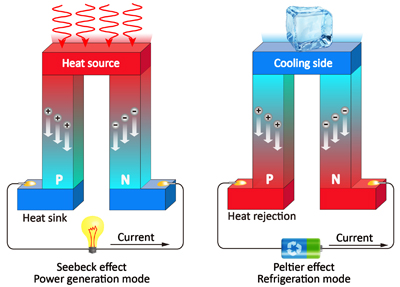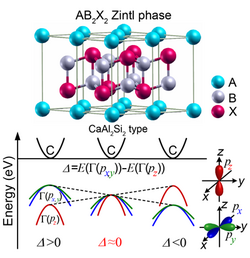Thermoelectric materials have drawn immense attentions for years. They can enable direct conversion between electrical and thermal energy, hence providing an alternative for refrigeration and power generation.
Today, more than 60% of the produced energy is lost in vain worldwide, predominantly in the form of waste heat. High performance thermoelectric materials is an environment-friendly energy conversion technology with the advantages of small size, high reliability, can work in a wide temperature range, and have no pollutants.
Nonetheless, the efficiency of thermoelectric devices is yet not high enough to be an alternative to the Carnot cycle. At Aarhus University new thermoelectric materials are developed and optimized in order to prepare high performance thermoelectric devices.


At CMC new thermoelectric materials are developed and existing materials are prepared in different ways in order to optimize their performance. The dimensionless figure of merit, zT, is given by the equation zT = α2σT/κ where α is the Seebeck coefficient, σ is the electrical conductivity, κ is the thermal conductivity, and T is the absolute temperature.
The material ZnSb is one of the systems that are developed and improved at CMC. It is attractive in a thermoelectric context since it consists of cheap and earth abundant elements. It has a lower maximum zT than the familiar phase β-Zn4Sb3 and therefore not much attention has been drawn to the material. However, ZnSb has the advantages of being much more stable than β-Zn4Sb3 which easily undergoes phase transitions.

The structure of a material is the foundation to understand and explain material properties. Ba8Ga16Ge30 is a thermoelectric material which are able to host guest molecules within the cavities.

Thermoelectric technology calls for novel high-performance materials. Orbital engineering is a new approach that can be used to describe, discover and design thermoelectric materials.
In the figure to the right the unit cell of layered CaAl2Si2-type Zintl compound is shown. Underneath, an illustration of orbital engineering is illustrated in the compound. Three scenarios showing different interactions between the electronic bands are illustrated. The figure shows that the energy in the system depends on how the orbitals interact.
The results showing here is published in Nature Communications, DOI: 10.1038/ncomms10892
At CMC, we contributed to the discovery of n-type Te-doped Mg3Sb1.5Bi0.5. In 2012, n-type TE performance with a maximum zT of ~0.91 at 673 K in Mg3Sb1.5-0.5xBi0.5-0.5xTex was originally shown by Steffen H. Pedersen in his chemistry project report as part of the master thesis, which is publically available at the AU library. A PDF version of Steffen H. Pedersen’s thesis is now available online by following this link. After systematic efforts on reproducing and improving the original work of Steffen H. Pedersen, Jiawei Zhang et al. reported n-type Mg3Sb1.5-0.5xBi0.5-0.5xTex with varying Te content synthesized by combining arc melting and spark plasma sintering (SPS) at 1123 K. An optimal zT of 0.56-1.65 at 300-725 K was found in n-type Mg3Sb1.48Bi0.48Te0.04, which shows the intrinsic temperature-dependent mobility with the dominant acoustic phonon scattering at low temperatures. The result by Jiawei Zhang et al. is published here in Nature Communications.